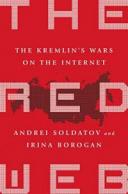Книга: The Red Web: The Struggle Between Russia
PROLOGUE
PROLOGUE
In an otherwise residential district of southwest Moscow, a nineteen-story gray-and-white high rise, surrounded by a modest fence, could at first glance be mistaken for an average apartment block. But there is something odd about it: Only twelve of the floors have windows.
This building is the heart of the Russian Internet: phone station M9, containing a crucial Internet exchange point known as MSK-IX. Nearly half of Russia’s Internet traffic passes through this structure every day. Yellow and gray fiber-optic cables snake through the rooms and hang in coils from the ceilings, connecting servers and boxes between the racks and between floors. Google rents an entire floor on M9 so to be as close as possible to the Internet exchange point of Russia. Each floor is protected by a thick metal door, accessible only to those with a special card.
On the eighth floor is a room occupied by the Federal Security Service, or Federalnaya Sluzhba Bezopasnosti, or the FSB, the main successor organization to the KGB, but the FSB’s presence is evident on all the floors. Scattered among the communications racks throughout the building are a few electronic boxes the size of a video player. These boxes are marked SORM, and they allow the FSB officers in the room on the eighth floor to have access to all of Russia’s Internet traffic. SORM stands for the Russian words meaning “operative search measures.” But, essentially, it’s a back door.
SORM boxes once intercepted just phone calls. Now they monitor e-mails, Internet usage, Skype, cell phone calls, text messages and social networks. It is one of the world’s most intrusive listening devices, and it is the Russian government’s front line in a monumental battle for the future of the Internet.
This book is a journey through this conflict as it has unfolded in Russia throughout a quarter century of tumult following the collapse of the Soviet Union, which sought to put information in a kind of prison, to the emergence of a new Russia. The book shows that in some ways, Russia did not break entirely with its Soviet past; the SORM boxes, invented by the KGB, have been constantly updated ever since and are used to this day against political opposition. In other ways, however, Russia has become an entirely new country of digital activists who have learned to use the Internet to elude government control and spread uncensored information. In 1991 Russia inherited a dysfunctional and broken communications system with barely a connection abroad, and today it stands in the top ranks of those developing countries that are wired to the world. In a global survey by the Pew Research Center, 73 percent of those questioned in Russia said they had online access, compared to 63 percent for China and 87 percent in the United States.[1] Our book is an investigation into these two great forces—surveillance and control on one side, and freedom on the other—and what happens when they collide. It does not yet have a definitive ending.
The significance of these events extends far beyond Russia, and not only because the Kremlin has repeatedly attempted to change the global rules of the Internet, to build national frontiers in what today is a wide open space. The events of 2016 proved that Kremlin cyber operations abroad could not be ignored.
We have interviewed dozens of participants in the events described and examined thousands of pages of documents. In a nation with a strong tradition of secrecy, even today, it is very difficult to find the truth or people to talk about it. This wall of silence became more pronounced after President Vladimir Putin returned to power in 2012 in the face of popular protests and tightened the flow of information by introducing new laws and practices of censorship and intimidation.
Part I of the book covers the Soviet collapse and the nearly two decades leading up to the Moscow protests of 2011–2012. Part II takes a closer look at some of the forces driving the conflict and what has happened since Putin’s return and the outbreak of violence in Ukraine. In 2016, it became increasingly clear that the Kremlin tried to export the tactics it uses against the opposition to other countries. For this edition, we have added an entirely new chapter about the hacking attack in the United States during the presidential campaign. As co-authors, we wrote the book together and refer to ourselves in the narrative by our first names. We researched and wrote this book not only as journalists but also as participants in the events we chronicle, as well as products of both the last of the Soviet years and the digital revolution itself.




